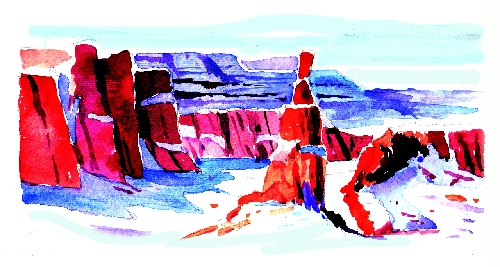Bryce Canyon National Park a special treat in winter

Winter works magic in Bryce Canyon National Park in Southern Utah. Snow frosts each of the weirdly eroded, wildly colored spires called “hoodoos,” setting each apart from its sparkling neighbors. No other time of year creates such contrasts.
Bryce Canyon lies 270 miles from Las Vegas by way of Interstate 15 north into Utah. Just north of St. George, turn off on Highway 9 toward Hurricane. You can follow this highway through Zion National Park on the way to Bryce Canyon, or you can avoid Zion by turning in Hurricane onto Utah 59/Arizona 389. This route takes you east to the border town of Fredonia, Ariz., and then north a few miles to junction with U.S. 89 in Kanab, Utah. Carry tire chains, as snow tire or chain requirements frequently follow heavy snowfalls in the region.
On either approach, drive north on U.S. 89 to Highway 12. Turn east through scenic Red Canyon to reach Highway 63, the park entrance road. An informal community of motels, restaurants and various services, Bryce Canyon City lies along Highway 12 near the park junction. The park lies 4½ miles from the junction near venerable Ruby’s Inn, the first accommodations available near Bryce Canyon after it became a park in 1928.
Despite several feet of snow deposited during an average winter, Bryce Canyon remains open so visitors can experience the season’s marvelous scenery. Expect a park entrance fee of $25 per vehicle, reduced or waived for holders of federal recreation passes. Winter visitors find welcome at the visitor center, open at this time of year from 8 a.m. to 4:30 p.m. It contains exhibits, a theater and a well-stocked bookstore. Nearby North Campground offers tent and RV sites with limited facilities in winter, available on a first-come basis for $15 per night. Pass holders pay less.
The historic Bryce Canyon Lodge closes for the winter. Visitors seeking accommodations near the park find a selection of motels and at least one RV park in Bryce Canyon City. Reservations are necessary, especially on weekends and during the upcoming Bryce Canyon Winter Festival, scheduled annually over Presidents’ Day weekend, slated this year on Feb. 19-21.
The park’s road to viewpoints along the eroded rim is kept plowed and open for winter visitors. The road skirting the edge of the high, forested plateau that creates the geological wonderland of Bryce Canyon never fails to enthrall. Unplowed roads and some trails invite exploration. The park service encourages winter activities such as snowshoe touring, winter hiking, cross-country skiing, photography and stargazing. It prohibits the use of snowmobiles in the park, which are welcome on groomed trails near Highway 12 in the adjacent national forest. Because of the danger of avalanches and snow-mud slides on the rim, as well as the damage to the landscape, visitors may not ski or sled over the edge into the canyon. There are good sledding areas and miles of cross-country skiing routes in the national forest. Snowmobile rentals are available in Bryce Canyon City with groomed trails nearby.
Inquire about winter activities within the park at the visitor center. Park staff and volunteers offer a winter schedule of geology talks, snowshoe treks and astrology nights. Snowshoes are available free of charge to participants in ranger-guided snowshoe treks offered on weekends and as needed on weekdays. Reserve your place on one of these tours by calling the park at (435) 834-4747. A strenuous activity, snowshoeing is best done when the snow is powdery. As it packs down and gets icy, hiking boots with traction devices are recommended for getting safely around on foot. The park bookstore sells traction devices for $27.
On moonless nights, Bryce Canyon is one of the darkest places in the Southwest, offering splendid views of night skies. Dark-sky rangers introduce visitors to starry skies as they have never seen them before, particularly if they are from cities where stars at night have all but disappeared in the glare of outdoor lighting. Participants in stargazing sessions bundle up for outdoor viewing using telescopes provided by the park service, as well as by volunteers.
Margo Bartlett Pesek’s column appears on Sundays.












